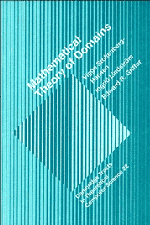Book contents
- Frontmatter
- Contents
- Preface
- Chapter 0 Preliminaries
- Part I Basic Theory
- Chapter 1 Fixed Points
- Chapter 2 Complete Partial Orders
- Chapter 3 Domains
- Chapter 4 Domain Equations
- Chapter 5 Topology
- Chapter 6 Representation Theory
- Chapter 7 A Universal Domain
- Part II Special Topics
- References
- Index of Symbols
- Index
Chapter 6 - Representation Theory
Published online by Cambridge University Press: 05 June 2012
- Frontmatter
- Contents
- Preface
- Chapter 0 Preliminaries
- Part I Basic Theory
- Chapter 1 Fixed Points
- Chapter 2 Complete Partial Orders
- Chapter 3 Domains
- Chapter 4 Domain Equations
- Chapter 5 Topology
- Chapter 6 Representation Theory
- Chapter 7 A Universal Domain
- Part II Special Topics
- References
- Index of Symbols
- Index
Summary
In section two of chapter three we proved a representation theorem stating that a domain D is, up to isomorphism, the ideal completion of its compact elements, Dc. An ordered set having the properties derivable for Dc was christened a cusl or conditional upper semilattice with least element. It turns out that a somewhat weaker version of cusl's, namely precusVs, serves just as well as a representation of domains and is better suited for the purposes of the last section of this chapter, which deals with solutions of domain equations to identity. In this chapter we sketch, without detailed proof, the basic results known on the representation of domains in this sense.
We begin with two additional representations of domains, information systems and formal spaces. Both have their origins in the works of D. S. Scott, Scott [1982] and [1982a], where the latter were presented in a less general form as neighbourhood systems. The versions presented here differ at some points from those of Scott for reasons to be explained later. Each of these three representations has its own particular point of departure. Cusl's and precusl's, by virtue of their emphasis on an ordering, give an algebraic representation. Information systems, based upon a relation of entailment, give a logical representation in analogy with the corresponding notion in formal logical systems. Finally, formal spaces, through their emphasis upon a relation of (formal) inclusion between neighbourhoods, provide a topological representation.
- Type
- Chapter
- Information
- Mathematical Theory of Domains , pp. 136 - 161Publisher: Cambridge University PressPrint publication year: 1994

